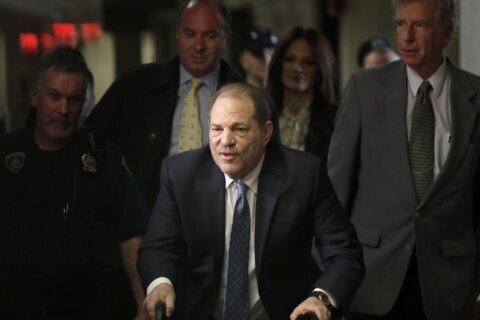NEW YORK (AP) — In a hushed and empty Broadway theater, two men appear onstage in street clothes, each wielding fearsome-looking broad swords. One lunges at the other, who quickly strikes back. They exchange a flurry of slices and counter-slices, with the screech of metal on metal.
Watching it with a smile is B.H. Barry, the legendary fight director who is choreographing this clash for a lush new revival of “Camelot” at Lincoln Center Theater. An hour before every show, he leads the actors through their movements, like a conductor with an orchestra of lethal instruments.
“I’m having fun,” he says. “It’s back to being an acting scene and not a fight scene, which is what you want. Ideally, I want it to be when the audience doesn’t know what I’ve started and what I’ve finished.”
The fight scene he created for “Camelot” is pure poetry, a mix of muscle, humor, ballet, pride and aluminum swords. There are actually three mini-fights, with escalating levels of intensity, until the last combatants wield two swords each.
Barry, 83, created it from his imagination. In the original musical, there’s a joust, but it’s offstage and the audience never sees it. “My job is give me a script, give me a problem, and let me try and solve it for you,” he says.
Fergie Philippe plays one of the fighting knights, and he admits he was reluctant to do the scene, fearful he’d hurt someone. He credits Barry with empathy and encouragement, letting him come to the fight at his own pace.
“He doesn’t yell, he doesn’t scream, he doesn’t taunt, he’s not a belittling person. He’s a man who understands humanity very deeply, and he understands storytelling,” says Philippe. “And the basis of everything that he does always is going to come from that place. It’s why he’s worked for so long. It’s why he’s a legend in the fight community and in the theater community.”
This may be Barry’s last fight scene. A proud grandfather, Barry is tired of battling New York’s winters. Florida beckons. He may return to consult here or there, but it’s time for this faux fighter to hang up his gloves. “I like what I’ve done. I’m very proud of what I’ve done. And now is the time, I think,” he says.
Barry helped bring rigor, safety and artistry to fight scenes in England onstage and TV and then was lured to America in the 1970s to teach and spread his unusual sort of magic. “There are very few people like me,” he says. “I’m a kind of a niche product.”
He’s worked with everyone from Richard Harris and Susan Lucci to Kelsey Grammer, Ethan Hawke and Rudolf Nureyev on works by Harold Pinter and Arthur Miller to David Mamet and Tennessee Williams.
“I think it’s probably safe to say that very few people have had such an influence over one part of our work the way he does,” says Tony Award-winning director Bartlett Sher. “He’s been traditionally known as one of the greatest fight directors that we’ve ever had.”
Barry is the only fight director to earn a Tony Award, an honor extended for excellence in the theater. In his speech, he graciously thanked all the people like him — stage managers, props people and ushers — who work behind the scenes.
He’s not sure if there should be a specific Tony for fight choreography. “I would be scared to death if there were a category where people would be risking actors to get the recognition of being a fight director.”
His tools are swords, daggers, boxing gloves and fists. He knows slaps, too, having worked for 17 years on the soap opera “All My Children.” He designed the huge army battles in “Glory” and choreographed an attempted rape and violent brawl with hammers and shovels for Susan Sarandon in the play “Extremities.”
“Sometimes it keeps me awake at night because I try to understand why that violence takes place,” he says. “I’m not frightened of violence. It’s a way of expressing something that you can’t do with words.”
He’s crafted struggles on “Doctor Who” and Wednesday’s fencing scene in “The Addams Family” and even advised on animated characters fighting in 1998’s “Mulan.” If you look carefully at Roman Polanski’s 1971 “Macbeth,” you’ll see Barry, in a suit of armor, quietly stepping in for actor Terence Bayler as Macduff in the climactic final hand-to-hand combat.
“B.H. is in a long line of these kind of great artisans who work in the world of fight choreography,” says Sher. “Just to have him in the room and to have his experience and to have his wisdom is just an extraordinary gift to the work.”
Barry’s legacy is dozens of memorable theater, opera, film and TV fights, but it’s also his students. He has trained 10 proteges to spread his philosophy, each having worked under the master for three years.
While his vocabulary may be violence, Barry is effortlessly courteous and friendly, elegant and endlessly encouraging. “I will never let you down if I promised you something, and I will be fair with you,” he says.
He has taught at The Royal Academy of Dramatic Art, Guildhall School of Music and Drama, Yale, Temple, NYU and The Juilliard School. In 1968, he co-founded the Society of British Fight Directors, now called the British Society of Dramatic Combat.
For every job he lands, he first questions whether it actually needs him. “I look at the script,” he says. “I take the fight away from the script. Now, if there’s nothing missing, then we shouldn’t be doing a fight. It’s gratuitous.”
If the fight is justified, he evaluates what skills the actors bring. “I see how you move when you come in the room. And I think what your potential is. Now, that’s part of my skill — being able to read the body and know what it can do.”
Barry overcomes any actor’s reluctance or fear by connecting the fight scene back to acting, comparing each thrust or punch to a line of dialogue. What is happening in this scene? What is the motivation?
“You have to be able to impart the information in such a way that the actor can blossom. You don’t want him to be terrified when he comes onstage because he’s trying to do your choreography.”
He then likes to hand the actors wooden sticks to emphasize that it’s not about the weapons. “You could do that fight with loofahs and with pots and pans — that’s exactly the same fight.”
He believes that if the actor is fearful, the audience will be, too, and that will take them away from the work. “I’m into the suspension of disbelief. If I haven’t created that for you, I’ve not created it,” he says.
He likes to ask ushers and stagehands if the scene he’s designed is really working. He wants honest feedback. “I have an ego, but I’m an ego-less when it comes to the work,” he says.
Growing up in England, Barry wanted to be an actor and attended drama school at night while working at a lumber yard. He studied ballet, tap, mime and became a black belt in Aikido, using those skills while studying stage combat with his friend and mentor, Barry Jackson.
He began a second career in stunt work when he realized he could earn two paychecks at the same gig — acting and fight choreography. Thus, the actor born Barry Halliday gave birth to B.H. Barry, the fight director.
In the UK, he worked at the Royal Shakespeare Company, The Royal Court and the West End. In the U.S., he helped create Shakespeare & Company in Massachusetts. He wrote the guide “B.H. Barry Fights for Everyone.”
A near-constant in his career has been William Shakespeare, having worked on many of the playwright’s works. The Bard was skimpy with his script directions — often writing just “They fight” — and leaving it to Barry to fill in the blanks. He jokingly calls Shakespeare “a 16th century man who gave me a living.”
Barry stunned himself recently by reciting lines from “Richard II” (“For God’s sake, let us sit upon the ground/And tell sad stories of the death of kings”) even though he’d never memorized them. No longer working on Shakespeare plays will be the thing he most regrets: “If I’m going to miss anything, it’s got to be that.”
The future of stage and screen combat is secure, he thinks. He may not be present, but there will always be more fight scenes. “Steinbeck said, ‘All war is a symptom of man’s failure as a thinking animal,’” Barry says.
___
Mark Kennedy is at http://twitter.com/KennedyTwits
Copyright © 2024 The Associated Press. All rights reserved. This material may not be published, broadcast, written or redistributed.







